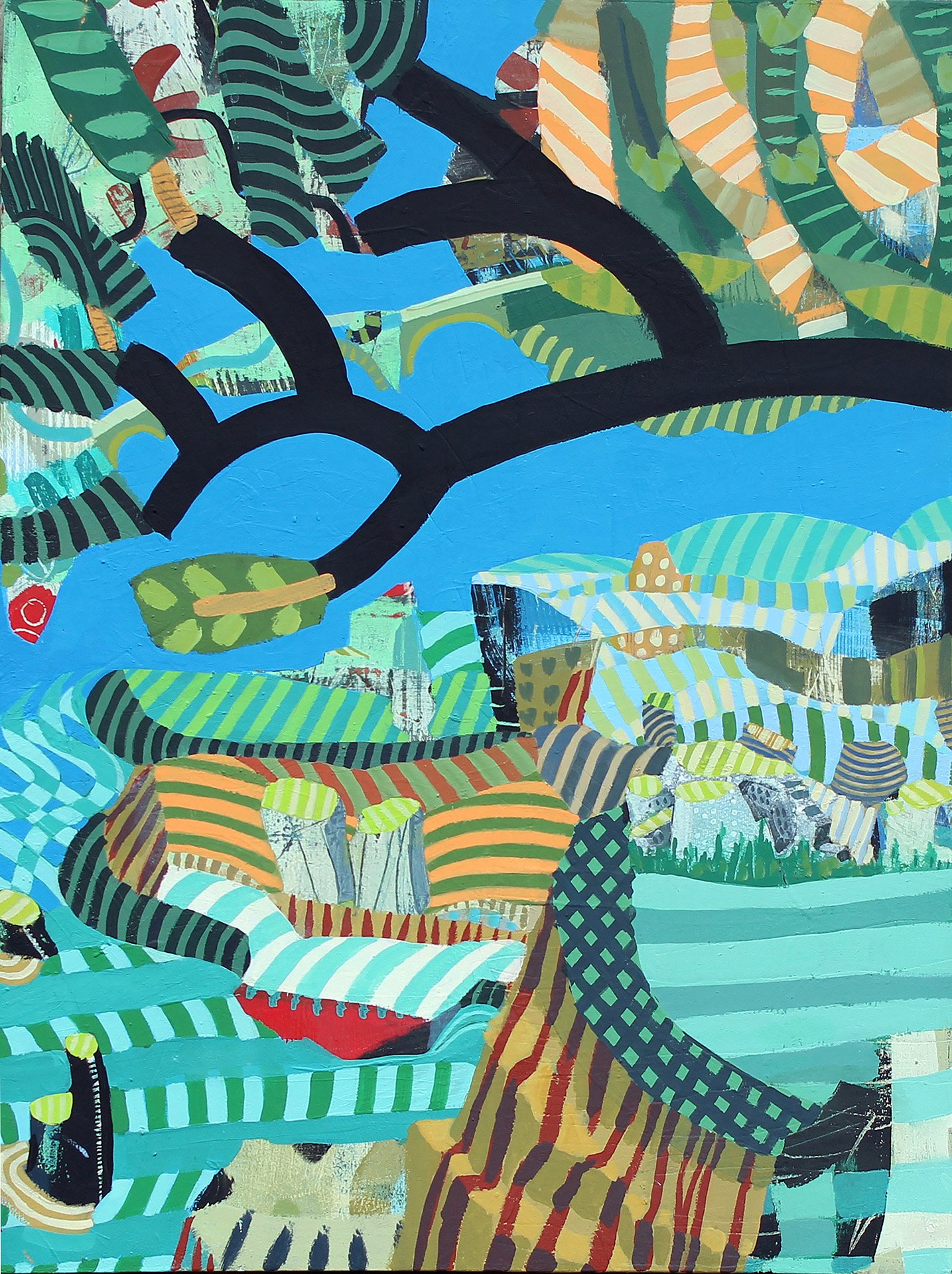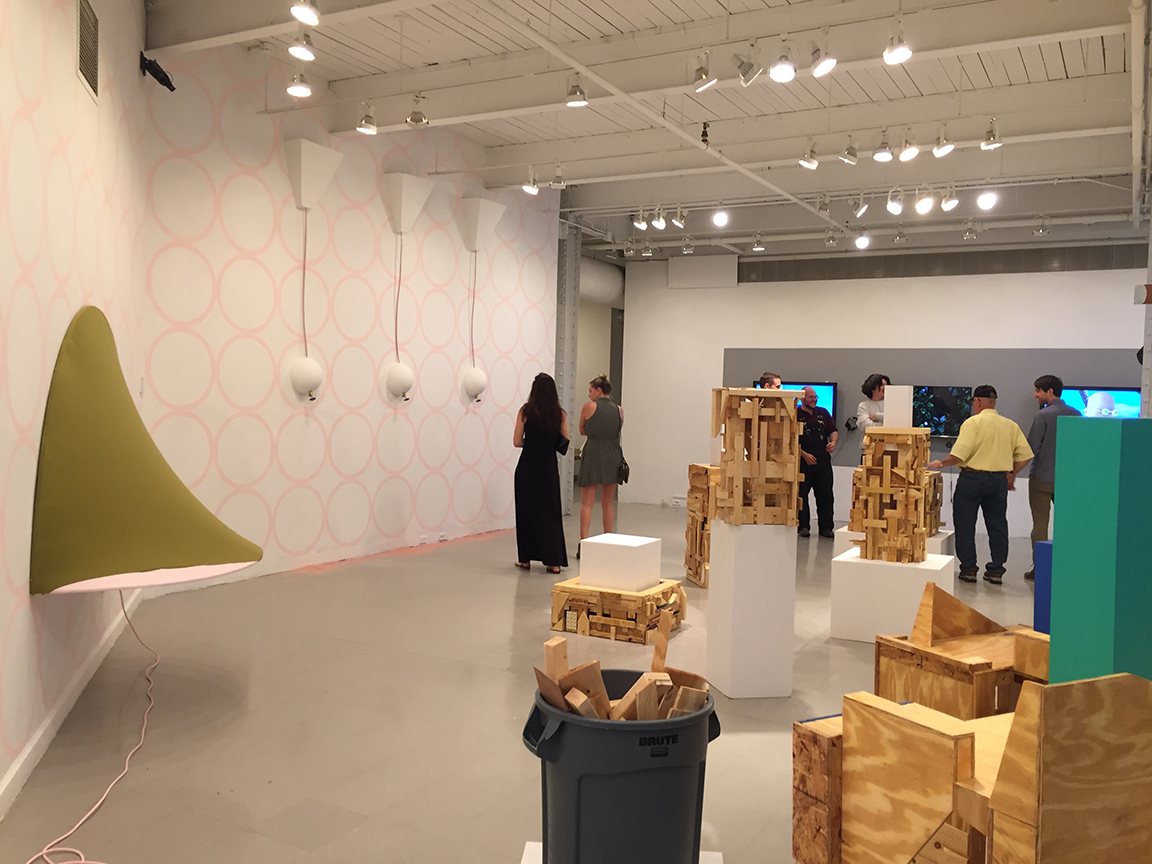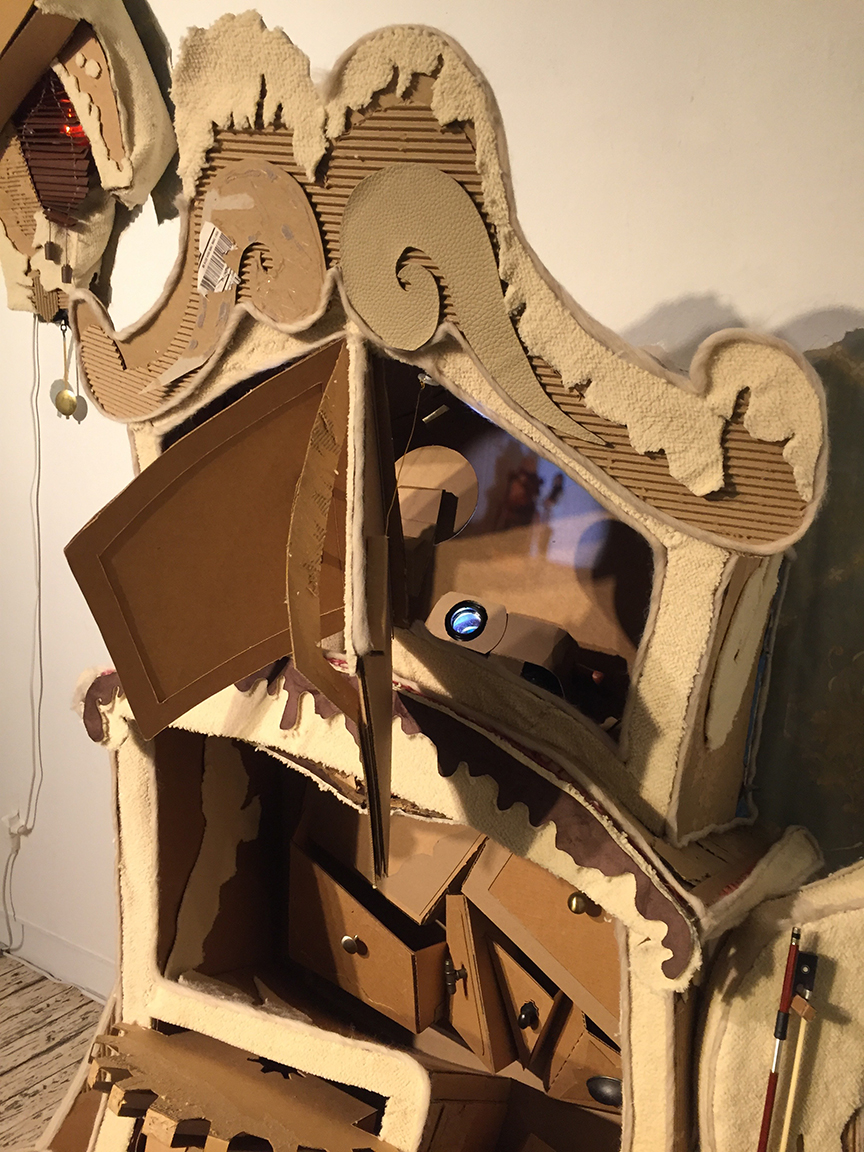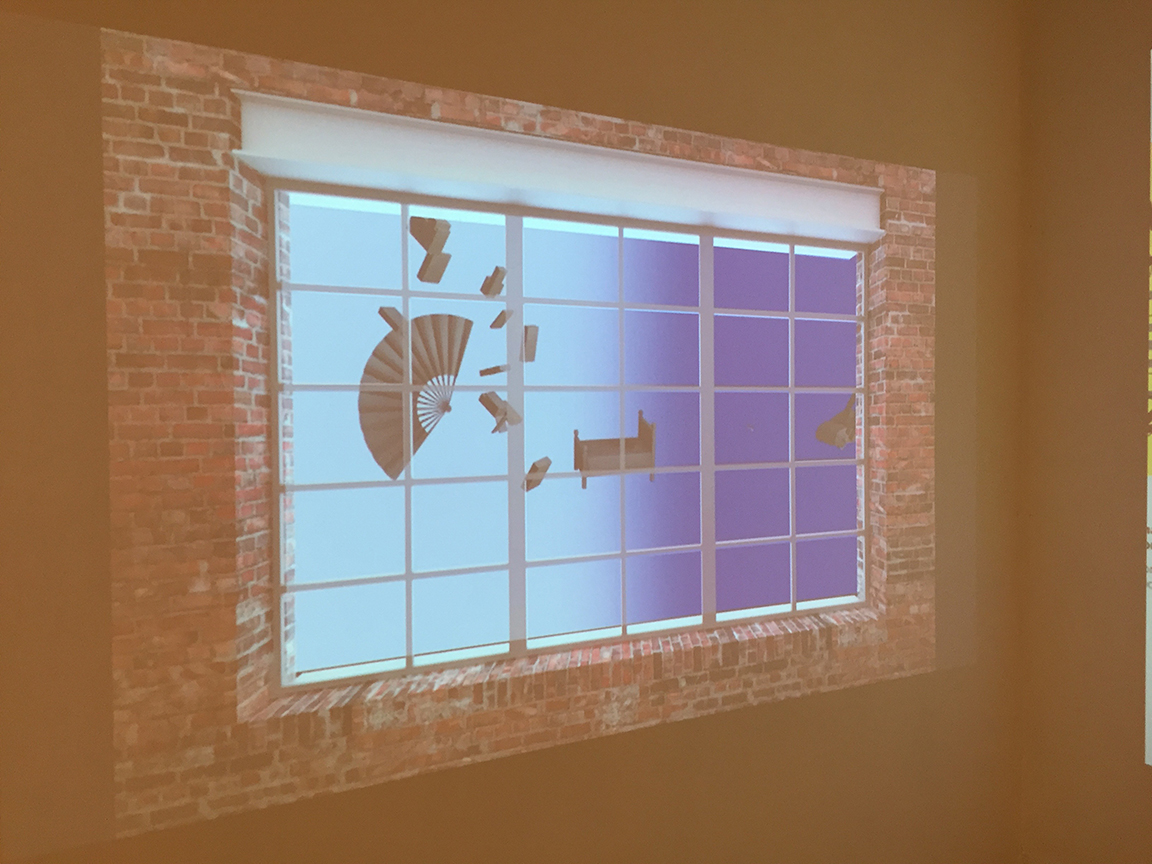MICA Ups the Ante with a Curated, Thematic Approach to MFA Thesis Shows by Amy Boone-McCreesh
MICA’s sprawling MFA Thesis Show III was curated by Doreen Bolger, former director of the Baltimore Museum of Art and Seth Adelsberger, artist and former co-director of Nudashank gallery. The curators chose to organize work by theme into shows, rather than sort by program or medium.
Categories presented for the on-campus exhibitions included titles like “Conversing with Text,” “Challenging Artistic Conventions,” and “Exploring Heritage;” themes broad enough to allow a wide range of works to exist together but specific enough to create small conceptual anchors throughout. The shows were divided by gallery, totaling five across campus.
Exhibition One, hosted on campus, presented a mix of work from different MICA graduate programs and was noticeably more tech-heavy than in past years. Video, projections, and virtual reality were not reserved only for the Photographic and Electronic media candidates, but included traditional painters and sculptors as well, all reinforcing the notion that technology has become more pervasive than ever into our lives and in art.
In Exhibit One, the use of technology felt necessary, rather than frivolous; showing that new media is an appropriate way of communicating visually, as it often mimics or criticizes the technology bombardment and integration most of us deal with daily.

Lazarus Center – “Confronting Oppression”
The Lazarus Center on North Avenue houses the “Confronting Oppression” portion of the exhibition featuring works by Community Arts, Hoffberger School of Painting, Mount Royal School of Art, Rinehart School of Sculpture and Photographic and Electronic Media candidates.
Within the entrance of the building, viewers are enticed by what looks to be a job fair or a table to advertise products at a conference or trade show. Community Arts MFA candidate Kim Loper master-minded the eerily convincing campaign for the pseudo-drug Denylium.
Kim Loper
Denylium is a (fake) drug geared towards those suffering from Chronic Racial Anxiety Syndrome also known as CRAS, according to Loper. The brochures, posters, and cards assure those interested that once taken, the drug can allow you to “Live your greatest life, guilt free.” The clever campaign pokes at serious and perpetual issues in the United States and beyond involving race and stereotypes. Loper’s commitment to the pharmaceutical aesthetic is impressive; see more here.

 Xiaomeng Cai
Xiaomeng Cai
Around the corner, on the first floor of the Riggs gallery is the work of Xiaomeng Cai. Cai is an MFA candidate in Photographic and Electronic Media. This work is created around the 24/7 “news” channel in China, Xianwen Lianbo. The channel serves as a continuous stream of political agendas wrapped in the context of news. On the walls Cai hand-painted a cultural mash-up to serve as the environment for the piece. It features Dragon Ball-Z, Pokemon, and what looks to be Chinese workers and icons. The video portion of the work pairs cartoon clips with 2016 clips from the “news” channel.

 Mandy Chesney
Mandy Chesney
The work of Mandy Chesney deals with confronting oppression head on; her work presents like funeral displays and the text for the work offers statistics on sexual assault. Staggering numbers coincide with the reliquary-like works. Ninety percent of sexual assault abusers are known by their victims and eighty-five percent of children abused never report the abuse according to Chesney’s accompanying label. Her work operates as mostly objects with some text, tied through narrative and a universal social and human rights issue.
 Bryan Funk
Bryan Funk
Brian Funk uses existing imagery and data and repurposes it to exist in new, experimental ways. Funk’s most visually enticing piece JLENS babies is a collection of large white balloons with projections of found footage on top. JLENS is a United States surveillance project, manifesting as a large balloon or blimp. You may remember the recently escaped JLENS blimp that tore across Maryland and Pennsylvania. Funk’s balloon piece is an aesthetically pleasing and surprisingly soft visual, considering the content.


Jordan Kyler
Downstairs in the Leidy Gallery, Jordan Kyler’s work was installed under the stairs. Kyler is a candidate in the Photographic and Electronic Media program. Her work is installed in a way that provokes imagery of a teenage bedroom. Banners hang with many personas and accompanying words like “subversive” and “athletic babe.”
The work is an obvious criticism of social media and the multi-faceted issues inherent to internet culture. The series is titled Nowagaze which speaks to the (art) historical idea of the male gaze but also what we are dealing with right now in society. The Nowagaze campaign is as committed as Loper’s pseudo-pharmaceutical Denylium. You can visit the Nowagaze website that is comically geared towards men that have an interest in creating their ideal “babe”. Personalities include the “Playful Innocent Babe” and the “Flirty Sassy Babe” amongst others; all of which most women can surely recall an occasion where they were either lumped into or forced into these one-dimensional categories. I recommend spending time with the website, as it offers a nuanced and funny commentary on the way women are presented across current internet culture.
Also downstairs in the Lazarus building, works by Francesco Mazzota and James Bernard Cole.
 Francesco Mazzota
Francesco Mazzota
Mazzota’s work focuses on gender roles and the public and private self. James Bernard Cole, who is a Rinehart Sculpture MFA candidate created a large, interactive structure, complete with faux metal detectors and American flags.

 James Bernard Cole
James Bernard Cole
*************************
Space Camp- “Exploring Heritage”

The work in Space Camp at 16 W. North Avenue revolved around the idea of heritage and culture. Many of the artists spoke to social narratives and politics directly, and some in a subtler way. The work was diverse in media ranging from installation to painting, but the emphasis on video and technology prevailed.
 Effy Wang
Effy Wang
Effy Wang’s large scale abstract paintings aim to question reality and place. There are moments when imagery or influence from her native China emerge and quickly disappear.
 Anita Zhang
Anita Zhang
Anita Zhang, Photographic and Electronic Media, created a site-specific piece in the back corner of the gallery using thread, projections, and other mixed media. The result is an unnerving and beautiful piece that shifts color and form. A figure appears and walks away, as if they were in the space with you. This feeling is compounded when you realize a camera is also projecting your image into the space with the ghost figure. The piece is titled “Samsara” after the Buddhist concept associated with life and rebirth. Zhang hopes to tap into the cyclical notion as a way to confront Eastern and Western ideas on existence.
 Jiuxin Jin
Jiuxin Jin
Jiuxin Jin, also Photographic and Electronic Media presents what seems to be a set of unassuming forms made from craft paper. The forms actually house dynamic and wonderfully strange videos with the title “Crater Park”. The multi-channel short videos mash-up images of colonization and industrialization with Jin inserted into the spaces. The result is not only a culture and time clash but also a comedic and endearing look at loneliness and belonging in an ever-integrated cultural landscape, all ridden with historical blemishes.

 Ni Xin
Ni Xin
Some of the more visually demanding work in the space is made by Ni Xin, Mount Royal School of Art. Xin serves up many multi-media offerings, working in video, painting, and sculpture. Xin’s work all lives under a canopy made from the Chinese flag. Her pieces range from funny to serious, culminating with her most powerful work; American Apparel bags rebranded as Isis city bags. Vinyl lettering replaces the original iconic cities now with cities like Kuwait, Baghdad, Garland, and San Bernardino. Implicating U.S. cities on the bags rather than those of just the Middle East strengthens the far-reaching attempted effects of the terrorist group on the world and questions the norms of taste and fashion as being exempt from current events.
 Ni Xin’s Isis bags
Ni Xin’s Isis bags
 Xin with her work
Xin with her work
Decker and Meyerhoff Galleries- “Challenging Artistic Conventions” and “Considering Home”
The largest concentration of work lives in what most know to be the main galleries at MICA. The Decker and Meyerhoff galleries, like others, present work across all of the programs and are tied by the themes of home and artistic conventions.

Giulia Piera Livi
Giulia Piera Livi, Mount Royal School of Art. Livi’s work is a mod-like hybrid of function and decoration. Her large wall sculptures present as lights and her wall spouts suggest function, especially with the piles of pink powder on the floor below the work. This piece especially begged interaction, though many were unsure if they were meant to twist the knobs.
 Jihyun Vania Oh
Jihyun Vania Oh
Jihyun Vania Oh, Mount Royal School of Art (above)
One of my favorite pieces of the night was “Why should he console so many others when I want him only for myself” by Jihyun Vania Oh, Mount Royal School of Art. The mixed media piece uses Arduino sensors, video, and conventional sculptural methods to create a bizarre Disney gone wrong melting bureau. Each portion of the piece has a fake shadow, videos, and motion. This is another piece that should be seen in person to fully appreciate the kinetics and construction.

inside (l) and outside (r) views of the camper and it’s details
 “Wanderlodge” by Tara Margrit Bogart
“Wanderlodge” by Tara Margrit Bogart
Yifan Qin, Photographic and Electronic Media
Qin’s works are interactive and reactive, projecting visual memories of the motions you make in front of her space. The virtual spaces become very meta – also referencing the space you are in while viewing. One piece shows the window to the Fox building with objects flying by and the other includes not only the viewer’s body, but also the artwork (of another candidate) that is in the adjoining gallery space.
 Jonathon Baker
Jonathon Baker
Jonathon Baker, also Photographic and Electronic Media, shows four different videos, all starring a creepy biomorphic-humanoid form. The videos are accompanied by equally unsettling audio. While the pieces are visually weird, they are also funny. They cycle through disturbing and comical; reminding me of the absurdity often surrounding media and advertising. If you can’t see the work before the show ends (please do) you can view it here.

 Mieke Baran
Mieke Baran
Textiles integrated with and operating as paintings in a repetitive full-wall installation in the Meyerhoff gallery.
 SeungTack Lim
SeungTack Lim
Clever cards act as never-ending media labels for SeungTack Lim, Rinehart School of Sculpture.
Fox 3 gallery (third floor of the Fox building) – “Conversing with Text”
The top floor gallery space in the Fox building at MICA presented works that loosely revolved around an idea of communication. Maureen Delaney’s paintings are visually commanding when you step off of the elevator. Delaney’s abstract language uses gesture and mark as a means of communication.
 Maureen Delaney, Hoffberger School of Painting
Maureen Delaney, Hoffberger School of Painting
 Fox 3 gallery view, with Delaney and Jessica Cherry
Fox 3 gallery view, with Delaney and Jessica Cherry

 Tianqi Song
Tianqi Song
Also in the Fox 3 gallery were the works of Tianqi Song, Photographic and Electronic Media. Song’s work was presented primarily as a collection of photographs, all with an intriguing, ambiguous sense of scale and place.
 Yuqi Wang
Yuqi Wang
The small back room of Fox 3 gallery holds the work of Yuqi Wang. The room is dominated by a video of subtle motion that looks and feels like a 1980’s video game. The room also features sculptural objects, which you can see featured in one of the videos here.
Wang is a Photographic and Electronic Media MFA candidate.
Pinkard gallery – “ Exchanging Experience”
Lezlie Silverstein’s work is hard to miss when you enter the building. Silverstein, a Community Arts candidate created the program the “SPACEmakers” an after-school program that focuses on transforming spaces within their school. She partnered with local youth in the program to create this collaborative piece.
 Lezlie Silverstein
Lezlie Silverstein
 Yuan Tang
Yuan Tang
Past Silverstein’s installation lies a quite collection of illuminated dishes. The dishes are Yuan Tang’s hair collections. Tang is a Photographic and Electronic Media candidate interested in how hair operates as function and decoration for the body.
See a full list of candidates and to explore details and gallery hours (they differ) for the shows here.
—
The MICA Thesis III Exhibition closes April 30,2017.
Author Amy Boone-McCreesh is a Baltimore-based artist, writer, and professor.












